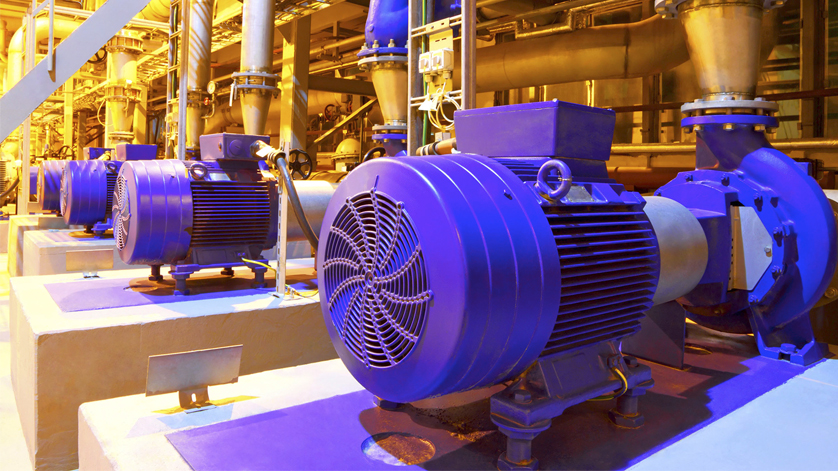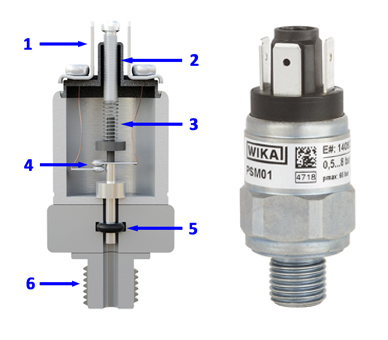
Mechanical pressure switches in compact design ensure safe pressure monitoring in, for example, pumps, compressors and mobile working machines. Regardless of the application, they function in accordance with the principle of the preloaded spring, with a diaphragm or a piston as the measuring element.

Mechanical pressure switches such as the PSM01 (see illustration) are constructed in accordance with the schematic diagram (left): electrical connection (1), adjustment screw (2), preloaded spring (3), switch contact (4), measuring element (5) and process connection (6). The model PSM01 and model PSM02 (with adjustable hysteresis) are compact switches. They have a height of 50 mm (version with blade terminal) and spanner widths of 24 and 27.
With this functional principle, two forces act:
- The process pressure
It makes the measuring element of the pressure switch react. The instruments are therefore designed in two ways. In the case of low process pressures, mechanical pressure switches therefore feature a diaphragm (as a result of the large surface area absorbing the pressure), whereas, at higher pressures, they have a piston with a small surface area. - The force of the preloaded spring
This is adjusted via the adjustment screw of the pressure switch. The further the screw is turned in, the stronger the force of the spring that the measuring element has to overcome. This is accompanied by an increase in the switch point’s value. The spring geometry is designed based on the required switching range. In accordance with the functional principle of the mechanical pressure switch, the switch point is defined by the degree of spring preload. It is set when the pressure increases, and the reset point is set accordingly when the pressure decreases.
What must be considered when selecting the setting range?
When selecting the setting range, it is essential for the user to consider the maximum system pressure to which the pressure switch is subjected. In the case of the WIKA compact instruments, PSM01 and PSM02 (with adjustable hysteresis), for example, this is 60 bar (diaphragm) and 350 bar (piston).
The setting range is smaller than the overload safety. This means that pressure spikes can be absorbed. This is important, for example, for idle-running protection in pumps. There, the system pressure can be many times higher than the switching value. Therefore, the PSM01 and PSM02 pressure switches in the piston version have a switching range of up to 320 bar. The diaphragm versions of these two models can switch up to a maximum of 16 bar. The comparatively small range is explained by the particularly sensitive measuring element, which offers high repeatability. A larger switching and overpressure range would consequently require a stronger diaphragm – at the expense of repeatability.
Note
Further information on the PSM01 and PSM02 pressure switches can be found on the WIKA website. You would like to buy pressure switches? In our WIKA online-shop you will find some of our standard designs. Should you have further questions, your contact will gladly help you.
Also read our posts
How does one set the switch point for mechanical pressure switches?
Mechanical vs. electronic pressure switches: Application areas
Mechanical vs. electronic pressure switches: Functionality

